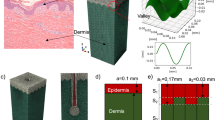Abstract
Arrays of arthropod filiform hairs form highly sensitive mechanoreceptor systems capable of detecting minute air disturbances, and it is unclear to what extent individual hairs interact with one another within sensor arrays. We present a computational fluid dynamics model for one or more hairs, coupled to a rigid-body dynamics model, for simulating both biological (e.g., a cricket cercal hair) and artificial MEMS-based systems. The model is used to investigate hair–hair interaction between pairs of hairs and quantify the extent of so-called viscous coupling. The results show that the extent to which hairs are coupled depends on the mounting properties of the hairs and the frequency at which they are driven. In particular, it is shown that for equal length hairs, viscous coupling is suppressed when they are driven near the natural frequency of the undamped system and the dam** coefficient at the base is small. Further, for certain configurations, the motion of a hair can be enhanced by the presence of nearby hairs. The usefulness of the model in designing artificial systems is discussed.












Similar content being viewed by others
Notes
Simulating multiple hairs is presented below.
Other criteria are possible (velocity, for example), but these are reasonable choices given the focus of current literature.
Note that due to boundary layer effects caused by the oscillating flow over the flat substrate, the free-stream velocities are not identical in the simulated results.
References
Bathellier B, Barth FG, Albert JT, Humphrey JAC (2005) Viscosity-mediated motion coupling between pairs of trichobothria on the leg of the spider Cupiennius salei. J Comp Physiol A 191:733–746
Bathellier B, Barth FG, Albert JT, Humphrey JAC (2010) Erratum to: Viscosity-mediated motion coupling between pairs of trichobothria on the leg of the spider Cupiennius salei. J Comp Physiol A 196:89
Bruinink CM, Jaganatharaja RK, de Boer MJ, Berenschot JW, Kolster ML, Lammerink TSJ, Wiegerink RJ, Krijnen GJM (2009) Advancements in technology and design of biomimetic flow-sensor arrays. In: 22nd IEEE international conference on micro electro mechanical systems (MEMS 2009), IEEE Computer Society Press, Sorrento, Italy
Cummins B, Gedeon T, Klapper I, Cortez R (2007) Interaction between arthropod filiform hairs in a fluid environment. J Theor Biol 247:266–280
Heys JJ, Gedeon T, Knott BC, Kim Y (2008) Modeling arthropod filiform hair motion using the penalty immersed boundary method. J Biomech 41:977–984
Humphrey JAC, Barth FG (2007) Medium flow-sensing hairs: biomechanics and models. In: Casas J, Simpson S (eds) Advances in insect physiology. Insect mechanics and control, vol 34. Elsevier, Amsterdam, pp 1–80
Humphrey JAC, Devarakonda R, Iglesias I, Barth FG (1993) Dynamics of arthropod filiform hairs. I. Mathematical modelling of the hair and air motions. Phil Trans R Soc London B 340:423–444 (See also Errata (1997) 352:1995)
Jacobs GA, Miller JP, Aldworth Z (2008) Computational mechanisms of mechanosensory processing in the cricket. J Exp Biol 211:1819–1828
Jaganatharaja RK, Bruinink CM, Hagedoorn BM, Kolster ML, Lammerink TSJ, Wiegerink RJ, Krijnen GJM (2009) Highly sensitive, biomimetic hair sensor arrays for sensing low-frequency air flows. In: Proceedings of the 15th international conference on solid-state sensors, actuators and microsystems, IEEE, Denver, pp 1541–1544
Krijnen GJM, Dijkstra MA, van Baar JJJ, Shankar SS, Kuipers W, de Boer JH, Altpeter D, Lammerink TSJ, Wiegerink RJ (2006) MEMS based hair flow-sensors as model systems for acoustic perception studies. Nanotechnology 17(4):S84–S89
Landolfa M, Miller J (1995) Stimulus-response properties of cricket cercal filiform receptors. J Comp Phys 177:749–757
Rogers SE, Kwak D (1991) Steady and unsteady solutions of the incompressible Navier–Stokes equations. AIAA J 29:603–610
Shimozawa T, Kumagai T, Baba Y (1998) Structural scaling and functional design of the cercal wind-receptor hairs of cricket. J Comp Physiol A 183:171–186
Yuan L (2002) Comparison of implicit multigrid schemes for three-dimensional incompressible flows. J Comp Phys 177:134–155
Acknowledgments
This research was funded by the Future and Emergent Technologies arm of the Information Society Technologies Programme, Sixth Framework Programme, IST-FETPI-016039. The authors would like to thank Gijs Krijnen and the MESA+ Institute for Nanotechnology, Universiteit Twente, for providing specifications for MEMS-based hair sensors and Jérôme Casas of the Institut de Recherche sur la Biologie de l’Insecte, Université de Tours, for his insight and valuable input on early drafts of this paper.
Author information
Authors and Affiliations
Corresponding author
Rights and permissions
About this article
Cite this article
Lewin, G.C., Hallam, J. A computational fluid dynamics model of viscous coupling of hairs. J Comp Physiol A 196, 385–395 (2010). https://doi.org/10.1007/s00359-010-0524-6
Received:
Revised:
Accepted:
Published:
Issue Date:
DOI: https://doi.org/10.1007/s00359-010-0524-6




